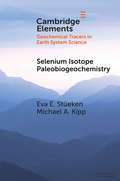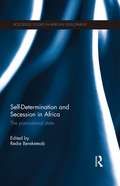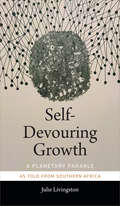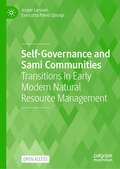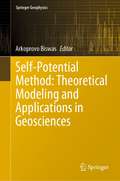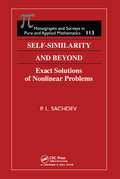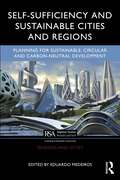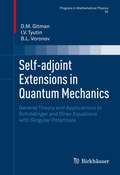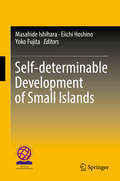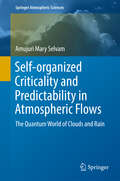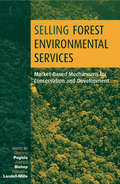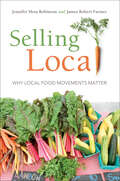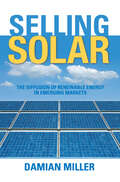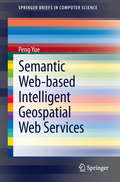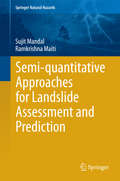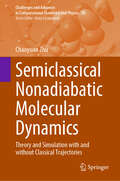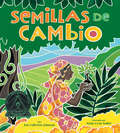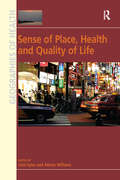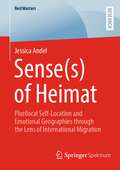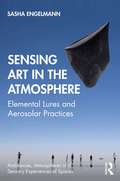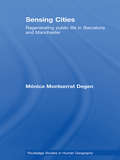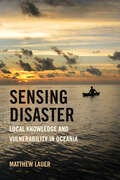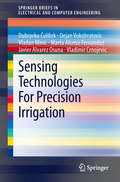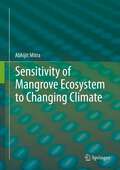- Table View
- List View
Selenium Isotope Paleobiogeochemistry (Elements in Geochemical Tracers in Earth System Science)
by Eva E. Stüeken Michael A. KippThe attraction of selenium isotopes as a paleoenvironmental tracer lies in the high redox potential of selenium oxyanions (SeIV and SeVI), the dominant species in the modern ocean. The largest isotopic fractionations occur during oxyanion reduction, which makes selenium isotopes a sensitive proxy for the redox evolution of our planet. As a case study we review existing data from the Neoarchean and Paleoproterozoic, which show that significant isotopic fractionations are absent until 2.5 Ga, and prolonged isotopic deviations only appear around 2.3 Ga. Selenium isotopes have thus begun to reveal complex spatiotemporal redox patterns not reflected in other proxies.
Self-Determination and Secession in Africa: The Post-Colonial State (Routledge Studies in African Development)
by Redie BereketeabThis book provides a unique comparative study of the major secessionist and self-determination movements in post-colonial Africa, examining theory, international law, charters of the United Nations, and the Organisation of African Unity (OAU)/African Union’s (AU) stance on the issue. The book explores whether self-determination and secessionism lead to peace, stability, development and democratisation in conflict-ridden societies, particularly looking at the outcomes in Eritrea and South Sudan. The book covers all the major attempts at self-determination and secession on the continent, extensively analysing the geo-political, economic, security and ideological factors that determine the outcome of the quest for self-determination and secession. It reveals the lack of inherent clarity in international law, social science theories, OAU/AU Charter, UN Charters and international conventions concerning the topic. This is a major contribution to the field and highly relevant for researchers and postgraduate students in African Studies, Development Studies, African Politics and History, and Anthropology.
Self-Devouring Growth: A Planetary Parable as Told from Southern Africa (Critical Global Health: Evidence, Efficacy, Ethnography)
by Julie LivingstonUnder capitalism, economic growth is seen as the key to collective well-being. In Self-Devouring Growth Julie Livingston upends this notion, showing that while consumption-driven growth may seem to benefit a particular locale, it produces a number of unacknowledged, negative consequences that ripple throughout the wider world. Structuring the book as a parable in which the example of Botswana has lessons for the rest of the globe, Livingston shows how fundamental needs for water, food, and transportation become harnessed to what she calls self-devouring growth: an unchecked and unsustainable global pursuit of economic growth that threatens catastrophic environmental destruction. As Livingston notes, improved technology alone cannot stave off such destruction; what is required is a greater accounting of the web of relationships between humans, nonhuman beings, plants, and minerals that growth entails. Livingston contends that by failing to understand these relationships and the consequences of self-devouring growth, we may be unknowingly consuming our future.
Self-Governance and Sami Communities: Transitions in Early Modern Natural Resource Management
by Jesper Larsson Eva-Lotta Päiviö SjaunjaThis open access book uses an interdisciplinary approach that not only focuses on social organization but also analyzes how societies and ecological settings were interwoven. How did early modern indigenous Sami inhabitants in interior northwest Fennoscandia build institutions for governance of natural resources? The book answers this question by exploring how they made decisions regarding natural resource management, mainly with regard to wild game, fish, and grazing land and illuminate how Sami users, in a changing economy, altered the long-term rules for use of land and water in a self-governance context. The early modern period was a transforming phase of property rights due to fundamental changes in Sami economy: from an economy based on fishing and hunting to an economy where reindeer pastoralism became the main occupation for many Sami. The book gives a new portrayal of how proficiently and systematically indigenous inhabitants organized and governed natural assets and how capable they were in building highly functioning institutions for governance.
Self-Potential Method: Theoretical Modeling and Applications in Geosciences (Springer Geophysics)
by Arkoprovo BiswasThe book deals primarily with the aspects of advances in Self-Potential geophysical data modeling, different interpretation techniques, new ideas and an integrated study to delineate the subsurface structures associated with exploration, contamination, buried paleochannels, archaeological investigations, glaciology, geomorphology, subsurface mapping and also in hydrocarbon exploration.The book is specifically aimed with the state-of-art information regarding research advances and new development in these areas of study, coupled to extensive modelling and field investigations obtained from around the world. It is extremely enlightening for the students, research workers, scientists, faculty members in Applied Geophysics, Near Surface Geophysics, Potential field, Electrical and Electromagnetic methods, Mathematical Modeling Techniques in Earth Sciences, as well as Environmental and other practical problems associated with Earth Sciences.
Self-Similarity and Beyond: Exact Solutions of Nonlinear Problems (Monographs and Surveys in Pure and Applied Mathematics #113)
by P.L. SachdevNonlinearity plays a major role in the understanding of most physical, chemical, biological, and engineering sciences. Nonlinear problems fascinate scientists and engineers, but often elude exact treatment. However elusive they may be, the solutions do exist-if only one perseveres in seeking them out.Self-Similarity and Beyond presents
Self-Sufficiency and Sustainable Cities and Regions: Planning for Sustainable, Circular and Carbon-Neutral Development (Regions and Cities)
by Eduardo MedeirosThe concept of self-sufficiency involves the notion of sustainable, circular, and carbon-neutral cities. This book examines how urban planning can lead to greater self-sufficiency.It sheds light on how urban and regional circular and self-sufficiency development can effectively contribute towards the ultimate goals of the United Nations (UN) Agenda 2030 and the European Union (EU) Green Deal. It not only embraces the scientific fields of regional and urban studies but also addresses environmental sustainability-related and regional resilience aspects, such as renewable energy production, sustainable mobility, and the circular economy. This book offers a full toolkit of knowledge on how to effectively implement planning approaches for circular and self-sufficiency development at both urban and regional levels. It begins by presenting a theoretical framework and debate on urban and regional planning approaches that can effectively make cities and regions circular and self-sufficient in certain development domains, such as producing intra-city electric energy, sustainable mobility, and promoting a circular economy. Further, it advances a range of policy development proposals aiming at providing a comprehensive introduction to contemporary thinking about how cities and regions can design innovative planning and governance processes and, where appropriate, build capacity to implement systemic and integrated climate-neutral policies, building on existing place-based territorial capital and experiences developed by local and regional networks. The chapters are written by established authors in their respective domains.This book will thoroughly prepare students and provide knowledge to academics, researchers, and policymakers in the fields of urban and regional planning/development and studies, environmental sustainability, regional resilience, human geography, economic development, and public/EU/UN policies.
Self-adjoint Extensions in Quantum Mechanics
by I. V. Tyutin D. M. Gitman B. L. VoronovThis exposition is devoted to a consistent treatment of quantization problems, based on appealing to some nontrivial items of functional analysis concerning the theory of linear operators in Hilbert spaces. The authors begin by considering quantization problems in general, emphasizing the nontriviality of consistent operator construction by presenting paradoxes to the naive treatment. It then builds the necessary mathematical background following it by the theory of self-adjoint extensions. By considering several problems such as the one-dimensional Calogero problem, the Aharonov-Bohm problem, the problem of delta-like potentials and relativistic Coulomb problemIt then shows how quantization problems associated with correct definition of observables can be treated consistently for comparatively simple quantum-mechanical systems. In the end, related problems in quantum field theory are briefly introduced. This well-organized text is most suitable for students and post graduates interested in deepening their understanding of mathematical problems in quantum mechanics. However, scientists in mathematical and theoretical physics and mathematicians will also find it useful.
Self-determinable Development of Small Islands
by Masahide Ishihara Eiichi Hoshino Yoko FujitaThis book aims to clarify the present situation of the relations between small island countries and territories on the one hand and the great powers, mainland areas, and mega-islands on the other, and explores how small island countries and territories preserve and build their identity under globalization. This book is divided into five parts. The first part presents papers on issues that are related to Okinawa: the American military presence, the formation of a global human network, and the history of and language revitalization in Okinawa. The second part includes papers on security in East Asia and the Pacific Region: the history of and present issues in international relations within the South and East China Sea areas. The third part presents papers on economic issues and social developments on small islands. The fourth part deals with ocean policies and marine resource management in the Pacific Region by the United States, Australia, and Japan. Finally, the fifth part presents papers on the revitalization of three indigenous languages. All the chapters of the book are based on the achievements of the research project "Towards New Island Studies: The Ryukyus as an academic node between East Asia and Oceania" conducted by the International Institute for Okinawan Studies at the University of the Ryukyus. This 5-year project was funded by the Japanese Ministry of Education, Culture, Sports, Science and Technology and aimed to contribute academically to the creation of sustainable and self-determinable societies in small island regions. This work will be extremely useful and informative for readers in small island countries and territories and for researchers who are interested in small island issues to understand the current situation and who wish to consider effectual and feasible solutions.
Self-organized Criticality and Predictability in Atmospheric Flows
by Amujuri Mary SelvamThis book presents a new concept of General Systems Theory and its application to atmospheric physics. It reveals that energy input into the atmospheric eddy continuum, whether natural or manmade, results in enhancement of fluctuations of all scales, manifested immediately in the intensification of high-frequency fluctuations such as the Quasi-Biennial Oscillation and the El-Nino–Southern Oscillation cycles. Atmospheric flows exhibit self-organised criticality, i.e. long-range correlations in space and time manifested as fractal geometry to the spatial pattern concomitant with an inverse power law form for fluctuations of meteorological parameters such as temperature, pressure etc. Traditional meteorological theory cannot satisfactorily explain the observed self-similar space time structure of atmospheric flows. A recently developed general systems theory for fractal space-time fluctuations shows that the larger-scale fluctuation can be visualised to emerge from the space-time averaging of enclosed small-scale fluctuations, thereby generating a hierarchy of self-similar fluctuations manifested as the observed eddy continuum in power spectral analyses of fractal fluctuations. The interconnected network of eddy circulations responds as a unified whole to local perturbations such as global-scale response to El-Nino events. The general systems theory model predicts an inverse power law form incorporating the golden mean τ for the distribution of space-time fluctuation patterns and for the power (variance) spectra of the fluctuations. Since the probability distributions of amplitude and variance are the same, atmospheric flows exhibit quantumlike chaos. Long-range correlations inherent to power law distributions of fluctuations are identified as nonlocal connection or entanglement exhibited by quantum systems such as electrons or photons. The predicted distribution is close to the Gaussian distribution for small-scale fluctuations, but exhibits a fat long tail for large-scale fluctuations. Universal inverse power law for fractal fluctuations rules out unambiguously linear secular trends in climate parameters.
Selling Forest Environmental Services: Market-Based Mechanisms for Conservation and Development
by Joshua Bishop Stefano Pagiola Natasha Landell-MillsThe risks posed by forest destruction throughout the world are highly significant for all. Not only are forests a critical source of timber and non-timber forest products, but they provide environmental services that are the basis of life on Earth. However, only rarely do beneficiaries pay for the goods and services they experience, and there are severe consequences as a result for the poor and for the forests themselves. It has proved difficult to translate the theory of market-based approaches into practice. Based on extensive research and case studies of biodiversity conservation, watershed protected and carbon sequestration, this book demonstrates how payment systems can be established in practice, their effectiveness and their implications for the poor.
Selling Local: Why Local Food Movements Matter
by James Robert Farmer Jennifer Meta RobinsonIn an era bustling with international trade and people on the move, why has local food become increasingly important? How does a community benefit from growing and buying its own produce, rather than eating food sown and harvested by outsiders? Selling Local is an indispensable guide to community-based food movements, showcasing the broad appeal and impact of farmers’ markets, community supported agriculture programs, and food hubs, which combine produce from small farms into quantities large enough for institutions like schools and restaurants. After decades of wanting food in greater quantities, cheaper, and standardized, Americans now increasingly look for quality and crafting. Grocery giants have responded by offering "simple" and "organic" food displayed in folksy crates with seals of organizational approval, while only blocks away a farmer may drop his tailgate on a pickup full of freshly picked sweet corn. At the same time, easy-up umbrellas are likely to unfurl over multi-generational farmers’ markets once or twice a week in any given city or town. Drawing on prodigious fieldwork and research, experts Jennifer Meta Robinson and James Robert Farmer unlock the passion for and promise of local food movements, show us how they unfold practically in towns and on farms, and make a persuasive argument for how much they deeply matter to all of us.
Selling Solar: The Diffusion of Renewable Energy in Emerging Markets
by Damian MillerTo solve the climate crisis, the world must make a wholesale shift to renewable energy technologies. With surging growth in emerging markets, this transformation takes on even greater urgency. The challenges - and opportunities - are immense. Selling Solar considers how such a shift might happen. Focusing on the case of solar photovoltaics, it shows how, at the start of the 21st century, this promising technology began to diffuse rapidly in select emerging markets, after years of struggling to take off. What were the initial barriers to diffusion? How were they overcome? Who did it? And how can this success be replicated? Drawing on literature on innovation diffusion and entrepreneurship, the author answers these questions, showing how entrepreneurs affected profound technological change not just through the solar systems they sold, but through the example they set to both new market entrants and policymakers. In analysing how this happened, this book offers important lessons for the diffusion of a range of renewable energy technologies in emerging markets, and for the advancement of the sector as a whole. Selling Solar is essential reading for anyone who believes in a renewable energy future and wants it sooner rather than later.
Semantic Web-based Intelligent Geospatial Web Services
by Peng YueBy introducing Semantic Web technologies into geospatial Web services, this book addresses the semantic description of geospatial data and standards-based Web services, discovery of geospatial data and services, and generation of composite services. Semantic descriptions for geospatial data, services, and geoprocessing service chains are structured, organized, and registered in geospatial catalogue services. The ontology-based approach helps to improve the recall and precision of data and services discovery. Semantics-enabled metadata tracking and satisfaction allows analysts to focus on the generation of a geospatial process model rather than spending large amounts of time in data preparation. "DataType"-driven service composition and path planning can help to automate a range of knowledge discovery processes in a limited geospatial domain. Process planning facilitates the construction of complex services and models for geocomputation. A three-phase procedure to cover the lifecycle of service chaining and to identify the roles of the methods involved is proposed. It includes process modeling, process model instantiation, and workflow execution. The approach is implemented in a prototype system with use cases to demonstrate applicability. The objective of the research is to develop the key technologies for an intelligent geospatial knowledge system based on Web services to automate the data discovery and data preprocessing steps in the distributed Web service environment, to automate a range of knowledge discovery processes in a limited geospatial domain, using the automated construction and execution of service chains, and to facilitate the construction of complex services and models for geocomputation.
Semi-quantitative Approaches for Landslide Assessment and Prediction
by Sujit Mandal Ramkrishna MaitiIn the present authors attempted to have a clear insight into the interworking of geotectonic, geomorphic, hydrologic and anthropogenic factors leading to landslide in the Shiv khola Watershed, the most worst affected region of Darjiling Himalaya. This book includes the parameters responsible for landslide events in mountainous areas. It provides knowledge and understanding to the local people, planners, and policy makers about the causes and consequences of landslides as well as provides a suitable method to mitigate the landslips. The book deals with the role of land, water and soil in landslide phenomena. These three attributes have been described in terms of critical rainfall, critical slope, critical height and changes and development of drainage network in landslides. Mitigations and site-specific management options are evaluated considering the roles of local govt. , community and other organizations in both pre-slide and post-slide periods. Various scientific methods have been used to assess the landslides that will bring about tremendous help to researchers in the field. In particular, Researchers in Mountain Geomorphology and Geological and Geographical Society will get tremendous help from some topics such as 1-D slope stability model, SCS Curve Number Technique, Assessment of morphological parameters, application of RS & GIS, Application of Analytical Hierarchy Process. Semi-quantitative approach is followed for understanding spatial distribution of cohesion, friction angle slope, lithology and lineaments, drainage, upslope contributing area, land use and land cover types etc. This book also reveals some techniques and models for initiating slope instability.
Semiclassical Nonadiabatic Molecular Dynamics: Theory and Simulation with and without Classical Trajectories (Challenges and Advances in Computational Chemistry and Physics #38)
by Chaoyuan ZhuThis book shows how to derive the simple and accurate semiclassical methods analytically and its applications to excited-state molecular dynamics and spectroscopy simulation with and without classical trajectories. It consists of eight chapters demonstrating interesting conical and intersystem-driven photochemical processes in complex systems targeting on large-scale ab initio direct nonadiabatic molecular dynamics. It also includes two chapters dealing with time-independent and time-dependent nonadiabatic molecular dynamics and clarifies the underline principle of Born–Oppenheimer approximation associated with coherence/decoherence quantum effects that have a wide range of applications in photochemistry and photophysics. This book is interesting and useful to a wide readership in the various fields of basic quantum chemistry and physics associated with large-scale excited-state simulation of nonadiabatic molecular dynamics and spectroscopy.
Semiclassical and Stochastic Gravity: Quantum Field Effects on Curved Spacetime (Cambridge Monographs on Mathematical Physics)
by Bei-Lok B. Hu Enric VerdaguerThe two pillars of modern physics are general relativity and quantum field theory, the former describes the large scale structure and dynamics of space-time, the latter, the microscopic constituents of matter. Combining the two yields quantum field theory in curved space-time, which is needed to understand quantum field processes in the early universe and black holes, such as the well-known Hawking effect. This book examines the effects of quantum field processes back-reacting on the background space-time which become important near the Planck time (10-43 sec). It explores the self-consistent description of both space-time and matter via the semiclassical Einstein equation of semiclassical gravity theory, exemplified by the inflationary cosmology, and fluctuations of quantum fields which underpin stochastic gravity, necessary for the description of metric fluctuations (space-time foams). Covering over four decades of thematic development, this book is a valuable resource for researchers interested in quantum field theory, gravitation and cosmology.
Semillas de cambio: Sembrando un camino hacia la paz (Seeds of Change: Planting a Path to Peace)
by Jen Cullerton JohnsonJohn Steptoe Award for New Talent in Illustrations - American Library Association (ALA)Una biografía ilustrada de la científica Wangari Maathai, la primera mujer africana (y la primera ambientalista) en ganar el Premio Nobel de la Paz por su trabajo sembrando árboles en su Kenia natal. A picture book biography of scientist Wangari Maathai, the first African woman--and first environmentalist--to win a Nobel Peace Prize for her work planting trees in her native Kenya.Cuando era niña en Kenia, a Wangari le enseñaron a respetar la naturaleza. Creció amando la tierra, las plantas y los animales que la rodeaban, desde los gigantescos árboles mugumo que su pueblo, Kikuyu, veneraban hasta los diminutos renacuajos que nadaban en el río. Aunque la mayoría de las niñas kenianas no recibieron educación, a Wangari, curiosa y trabajadora, se le permitió ir a la escuela. Allí su mente brotó como una semilla. Destacó en las ciencias y continuó sus estudios en los Estados Unidos. Después de regresar a casa, Wangari abrió un camino a través de Kenia, utilizando su conocimiento y compasión para promover los derechos de sus compatriotas y ayudar a salvar la tierra, un árbol a la vez. Semillas de cambio: Sembrando un camino hacia la paz le da vida a la historia poderosa de Wangari Maathai, la primera mujer africana y ambientalista en ganar un Premio Nobel de la Paz. Una narrativa cautivadora e imágenes vibrantes pintan un retrato sólido de esta inspiradora defensora de la tierra y de los derechos de las mujeres. As a young girl in Kenya, Wangari was taught to respect nature. She grew up loving the land, plants, and animals that surrounded her-from the giant mugumo trees her people, the Kikuyu, revered to the tiny tadpoles that swam in the river. Although most Kenyan girls were not educated, Wangari, curious and hardworking, was allowed to go to school. There, her mind sprouted like a seed. She excelled at science and went on to study in the United States. After returning home, Wangari blazed a trail across Kenya, using her knowledge and compassion to promote the rights of her countrywomen and to help save the land, one tree at a time. Seeds of Change: Planting a Path to Peace brings to life the empowering story of Wangari Maathai, the first African woman, and environmentalist, to win a Nobel Peace Prize. Engaging narrative and vibrant images paint a robust portrait of this inspiring champion of the land and of women's rights.
Sense of Place, Health and Quality of Life (Geographies of Health Series)
by Allison WilliamsA significant body of theoretical and empirical studies describes 'sense of place' as an outcome of interconnected psychological, social and environmental processes in relation to physical place(s). Sense of place has been examined, particularly in human geography, in terms of both the character intrinsic to a place as a localized, bounded and material entity, and the sentiments of attachment/detachment that humans experience and express in relation to specific places. Scholars in a wide range of disciplines are increasingly exploring the relationship between place and health, and recently, the field of public health has been encouraged to recognize sense of place as a potential contributing factor to well-being. It is evident that over the last few decades, sense of place has developed into a versatile construct. This important book brings together work related to sense of place and health, broadly defined, from the perspective of a variety of fields and disciplines. It will give the reader an understanding of both the range of applications of this construct within approaches to human health as well as the breadth of research methodologies employed in its investigation.
Sense: Plurilocal Self-Location and Emotional Geographies through the Lens of International Migration (BestMasters)
by Jessica AndelThe German notion of ‘Heimat’ is highly subjective, ambiguous and historically charged. Senses of belonging and identity associated with Heimat render the concept vulnerable to appropriation and instrumentalization by different political forces. Thereby, a static and exclusive understanding of Heimat is often depicted. This book drafts a counternarrative to demystify the contested concept. On the one hand, Heimat is conceptualized as spatial through emotional-geographical approaches to human-place relations. And on the other hand, the concept is placed in a global context through the perspective of international migration. The author contributes to the understanding of Heimat as an emotional map of self-location. This subjective map is neither purely static nor dynamic - it is characterized by simultaneities of opposing processes.
Sensing Art in the Atmosphere: Elemental Lures and Aerosolar Practices (Ambiances, Atmospheres and Sensory Experiences of Spaces)
by Sasha EngelmannThis book engages artistic interventions in the aerial elements to investigate the aesthetics and politics of atmosphere. Sensing Art in the Atmosphere: Elemental Lures and Aerosolar Practices traces the potential of artistic, community-driven experiments to amplify our sensing of atmosphere, marrying attentions to atmospheric affect with visceral awareness of the materials, institutions and processes hovering in the air. Drawing on six years of practice-led research with artistic and activist initiatives Museo Aero Solar and Aerocene, initiated by artist Tomás Saraceno, each chapter develops creative relations to atmosphere from the studio to stratospheric currents. Through narrative-led writing, the voices of artists and collaborators are situated and central. In dialogue with these aerographic stories and sites, the book develops a notion of elemental lures: the sensual and imaginative propositions of aerial, atmospheric and meteorological phenomena. The promise of elemental lures, Engelmann suggests, is to reconcile our sensing of atmosphere with the myriad social, cultural and political forces suspended in it. Through tales of floating journeys, shared envelopes of breath and surreal levitations, the book foregrounds the role of art in crafting alternative modes of perceiving, moving and imagining (in) the air. The book ends with a call for elemental experiments in the geohumanities. It makes an important and original contribution to elemental geographies, the geohumanities and interdisciplinary scholarship on air and atmosphere.
Sensing Cities: Regenerating Public Life in Barcelona and Manchester (Routledge Studies in Human Geography #14)
by Monica DegenAs cities globally re-design their urban landscapes, they produce a different urban aesthetic and create new experiential milieus. Urban regeneration processes generate radical physical, social and cultural changes in neighbourhoods that demand new conceptual frameworks to address their impact upon daily urban life. Sensing Cities investigates the reconfiguration of contemporary public space and life through the prism of the senses. The book explores how the increased stylization of cityscapes requires an understanding of public life as a spatial-sensuous encounter. Degen examines how power relations in public spaces are embedded in, exercised and resisted through the sensuous geography of place. This sensory paradigm is then applied to compare two emblematic regeneration projects, namely el Raval in Barcelona and Castlefield in Manchester. By combining detailed ethnographic analysis and interviews with those involved in planning regeneration processes and those experiencing them, the book argues that a changing sensuous landscape is crucial in redefining people’s social practices, attachments and experiences in places. Focusing on two European cities at the forefront of urban design, Barcelona and Manchester, Degen draws on sociology, geography, anthropology, cultural and architectural studies to provide a critical account of the politics of publicness in the entrepreneurial city. With numerous photographs and maps this book stresses the ongoing, embodied and active nature of regeneration as a lived social process rather than merely a physical or economic exercise. Ultimately, Sensing Cities examines how urban regeneration is made effective through the organisation of sensory experience. This book is essential reading for students and researchers of Architecture, Urban Studies and Human Geography.
Sensing Disaster: Local Knowledge and Vulnerability in Oceania
by Matthew LauerIn 2007, a three-story-high tsunami slammed the small island of Simbo in the western Solomon Islands. Drawing on over ten years of research, Matthew Lauer provides a vivid and intimate account of this calamitous event and the tumultuous recovery process. His stimulating analysis surveys the unpredictable entanglements of the powerful waves with colonization, capitalism, human-animal communication, spirit beings, ancestral territory, and technoscientific expertise that shaped the disaster’s outcomes. Although the Simbo people had never experienced another tsunami in their lifetimes, nearly everyone fled to safety before the destructive waves hit. To understand their astonishing response, Lauer argues that we need to rethink popular and scholarly portrayals of Indigenous knowledge to avert epistemic imperialism and improve disaster preparedness strategies. In an increasingly disaster-prone era of ecological crises, this provocative book brings new possibilities into view for understanding the causes and consequences of calamity, the unintended effects of humanitarian recovery and mitigation efforts, and the nature of local knowledge.
Sensing Technologies For Precision Irrigation
by Dejan Vukobratovic Marta Alonso Fernandez Vladan Minic Dubravko Ćulibrk Vladimir Crnojevic Javier Alvarez OsunaThis brief provides an overview of state-of-the-art sensing technologies relevant to the problem of precision irrigation, an emerging field within the domain of precision agriculture. Applications of wireless sensor networks, satellite data and geographic information systems in the domain are covered. This brief presents the basic concepts of the technologies and emphasizes the practical aspects that enable the implementation of intelligent irrigation systems. The authors target a broad audience interested in this theme and organize the content in five chapters, each concerned with a specific technology needed to address the problem of optimal crop irrigation. Professionals and researchers will find the text a thorough survey with practical applications.
Sensitivity of Mangrove Ecosystem to Changing Climate
by Abhijit MitraMangroves are basically salt tolerant forest ecosystems found mainly in tropical and sub-tropical inter-tidal regions. Till about 1960s, mangroves were largely viewed as "economically unproductive areas" and were therefore destroyed for reclaiming land for various economic and commercial activities. Gradually, with the passage of time, the economic and ecological benefits of mangroves have become visible and their importance is now well appreciated. Today, mangroves are observed in about 30 countries in tropical subtropical regions covering an area of about 99,300 Sq.Km. However, during the past 50 years, over 50% of the mangrove cover has been lost, mainly because of the increased pressure of human activities like shrimp farming and agriculture, forestry, salt extraction, urban development, tourist development and infrastructure. Also, dam on rivers, contamination of sea waters caused by heavy metals, oil spills, pesticides and other products etc. have been found to be responsible for the decline of mangroves. Although the temperature effect on growth and species diversity is not known, sea-level rise may pose a serious threat to these ecosystems The present book addresses all these important issues in separate chapters with some interesting case studies whose data may serve as pathfinder for future researches in the sphere of the influence of climate change on mangrove ecosystem. The role of mangroves in the sector of bioremediation is a unique feather in the crown of this coastal and brackishwater vegetation that may be taken up by the coastal industries in order to maintain the health of ambient environment. This book seeks to discover and to assess the vulnerability of climate change on mangrove flora and fauna, their role in carbon sequestration and some interesting case studies by some groups of dedicated researchers that may serve as the basis of future climate related policies.
